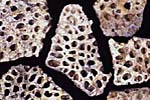

Green River Formation |
|||||||||||||
Location: Sweetwater County, Wyoming Time: 50 to 45 million years ago, during the Tertiary period About this Famous Find: The Green River Formation, exposed in northwest Colorado, southwest Wyoming, and northeast Utah, is what remains of a large lake that existed in the area ~ 60 to 38 million years ago. The lake system formed as water from the retreating Cretaceous Western Interior Seaway was trapped in basins in the foothills of the newly forming Rocky Mountains. During the Early Tertiary (Eocene), this region was located at much the same latitude as it is today, though the fossils, especially the plants, indicate that the climate was more sub-tropical. If you were able to visit the Green River at that time, you would have seen palms, cat-tails, sycamores, and other familiar plants from North America, but you also would have seen others more common to eastern Asia, such as Acrostichum, a large, coarse fern indigenous to Guam. The formation contains one of the most complete fossil assemblages of plants, insects, reptiles, fish, and mammals in the world. Approximately 60 vertebrate taxa have been found and although the majority of fossil material is fragmentary, some complete skeletons exist. The bat Icaronycteris index was extremely well preserved. Not only are its skeleton, membranes, and cartilage intact, but food remains are fossilized within its body cavity. This rare preservation makes the bat fossil very useful for paleontologists, providing evidence of the flora, algae, pollen, and arthropods living at the time. Invertebrate fossils are also abundant, and remains of snails and insects are fairly common.
Education and Exhibits Resources
|
|
site tour |
about the site |
site map |
site credits |
page credits |
help |
FAQs |
contact |
||

